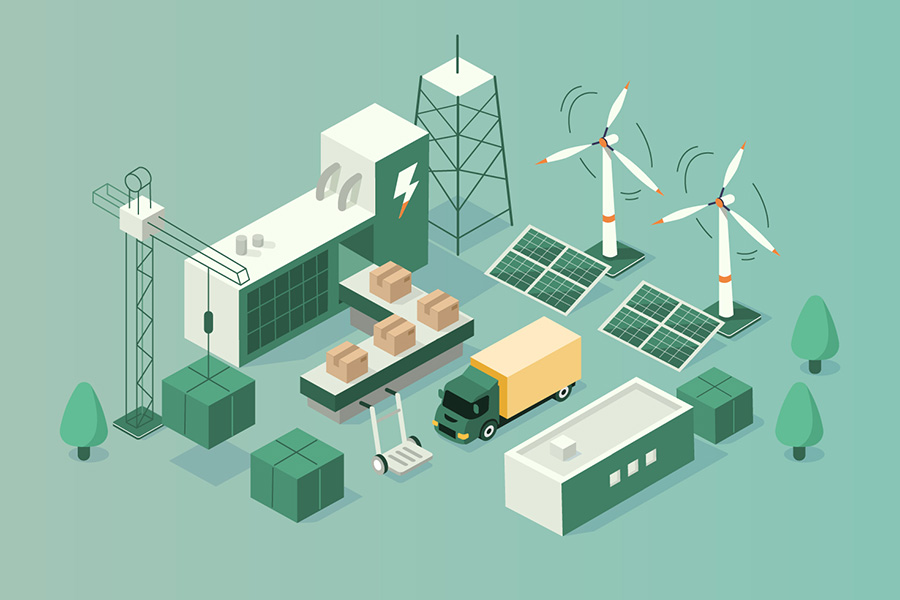Avoidance of energy waste and storage of energy
1. Heat recovery with ventilation and air conditioning systems
Room air handling units (AHUs) are used for heat recovery. These units use the temperature difference between the outside and inside air of buildings. The technology used is, for example, a plate heat exchanger or a rotary heat exchanger. This recovers the heat or coolness from the exhaust air of the building. In winter, the supply air can thus be warmed up to heat the building. In summer, the air is cooled. In addition to saving energy, this process also reduces CO2 emissions.
2. Intelligent energy storage with batteries
The way forward for energy efficiency in companies is the ability to also save generated energy.
Lithium-ion batteries are now standard in the field of battery technology. They are widely used in smartphones, vehicles and notebooks. Lithium-ion batteries are also used in home storage systems to store energy generated by photovoltaics. This means that the energy does not have to be fed into the power grid, but can be used by the user in the evening or at night, for example.
For large-scale systems, redox flow batteries are the right choice. These are liquid storage batteries that can store energy using a fuel and an oxidizer.
The fuel used is either vanadium oxide, sodium bromide or iron. The fuel and oxidizer are stored in separate tanks. Pumps and membranes complete the system. The batteries are used, for example, as buffer storage in wind turbines or as a backup source for mobile phone base stations. In the USA, the batteries are already being used for industrial applications.
Solid-state batteries dispense with liquid electrolytes, while lithium-ion batteries have salts present in solutions. They promise short charging times, long range and high fire safety at low cost. They are already being used, for example, in the eCitaro public bus.
3. Energy efficiency in the generation of compressed air
Companies that generate compressed air need a lot of energy to do so. Compressed air is needed, for example, in paint shops, but also for pneumatic tools. In addition, compressed air is used for cooling, heating and cleaning. Companies that have a large demand for compressed air should use the energy for it from surplus solar or wind power. This is more efficient than feeding the electricity into the general power grid.
4. Harnessing the power of water to generate energy
Pumped storage power plants are used in hydroelectric power plants to store energy. They are capable of black start. This means they can be used to help other power plants start up in the event of a large-scale power outage.
Spherical pumped storage units are currently being tested to store energy from wind farms in hollow concrete spheres under water. Initial experiments are underway at Lake Constance, for example. Physically, spherical pumped-storage units make use of inflowing water, which drives turbines when needed. The efficiency is comparable to that of a pumped-storage power plant. It is 75 to 80 %, depending on the volume and depth of the hollow sphere.
Large hot water storage tanks can be used to store hot water seasonally. For this purpose, water is heated by solar heat and temporarily stored in a hot water tank. One such system is located at the Ackermannbögen in Munich, for example. Compared to district heating, the system can significantly reduce CO2 emissions.
5. Heat and cold storage based on salt
In this variant, salt solutions are used to enable a phase transition from gaseous to liquid at favorable temperatures. This is because a relatively large amount of energy can be stored in the phase transition. The exact mechanism for heat transfer is still being worked on. As a result, this technology will probably not be ready for series production for a few years yet.
The energy saving opportunities in companies
One of the most important starting points is the use of the latest technology. This saves energy in many areas in companies.
One example is intelligent production. Modern control systems can be used to flexibly control processes and thus also reduce energy consumption. The networking and communication capabilities of the individual elements and machines make a decisive contribution to this. Intelligent production means using existing resources more efficiently. This means that greater output can be generated with the same input.
Part of the energy costs can be attributed to lighting. Here, intelligent lighting brings potential savings. A simple example is the installation of a motion detector. Especially in low-frequented areas this can bring big savings. Often, it goes unnoticed for days when lights are left on unnecessarily. In addition, companies can rely on daylight-dependent dimming or light colors. When it is bright enough, the lighting is automatically switched off. Above a certain threshold, the lighting switches on automatically. However, not at full intensity, but adapted to the actual need.

Saving energy with a new type of construction
Construction technology is constantly evolving and making a significant contribution to saving energy in buildings.
1. Greening facades and roofs
Green roofs and facades are not only an eye-catcher and make cities greener. Green facades change the microclimate and thus lower the ambient temperature. In the best case, air conditioning is no longer necessary in summer.
2. Intelligent glazing
There is also potential for savings in glazing. Here, functional glass ensures that solar radiation is reduced indoors. This also reduces the need for air conditioning. It is always worthwhile to replace single glazing with modern multi-insulating glass.
3. Photovoltaic systems on the facade
Photovoltaics on the facade has become a classic. Especially with south-facing buildings, electricity can be generated more efficiently. Of course, it is important that the facade is free-standing and that no other buildings cast shadows. In addition to the photovoltaic system, it makes sense to install an energy storage system.
4. Modern insulation
Insulation is the be-all and end-all when it comes to energy efficiency in buildings. In winter, it reduces heating requirements. In summer, it ensures low indoor temperatures. Building insulation options are available for the interior and exterior. It is also possible to retrofit existing buildings with better insulation.
5. Thermal component activation
Thermal component activation by means of concrete cores is still a comparatively young technology. In this case, the already existing concrete structure stores thermal energy. This can be used to heat or cool rooms. For cooling, the heat generated in summer is transferred to the ground. For heating, the heat of the ground is used. In order to use the technology, certain requirements must be met. These include, for example, a ground and groundwater temperature of 12 degrees. Thermal component activation is of interest for public buildings such as schools, hospitals or administrative buildings.
6. Infrared heaters
Used sensibly, infrared heaters save up to 50% energy compared to conventional heaters. They are ideal for rarely used rooms, where the installation and maintenance costs of a conventional heater would be significantly higher. It is important to combine the heater with a digital thermostat. Ideally, it is powered by electricity from a photovoltaic system.

